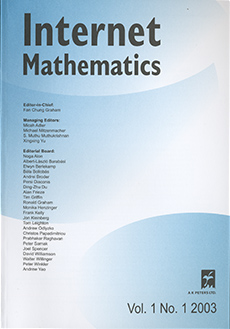Abstract
We consider a random subgraph $G_p$ of a host graph $G$ formed by retaining each edge of $G$ with probability $p$. We address the question of determining the critical value $p$ (as a function of $G$) for which a giant component emerges. Suppose $G$ satisfies some (mild) conditions depending on its spectral gap and higher moments of its degree sequence. We define the second-order average degree $\overline{d}$ to be $\overline{d} = \sum_v d^2_v/(\sum_v d_v)$, where $d_v$ denotes the degree of $v$. We prove that for any $\epsilon > 0$, if $p > (1 + \epsilon)/\overline{d}$, then asymptotically almost surely, the percolated subgraph $G_p$ has a giant component. In the other direction, if $p < (1 − \epsilon)/\overline{d}$, then almost surely, the percolated subgraph $G_p$ contains no giant component. An extended abstract of this paper appeared in the WAW 2009 proceedings. The main theorems are strengthened with much weaker assumptions.
Citation
Fan Chung. Paul Horn. Linyuan Lu. "Percolation in General Graphs." Internet Math. 6 (3) 331 - 347, 2009.
Information




